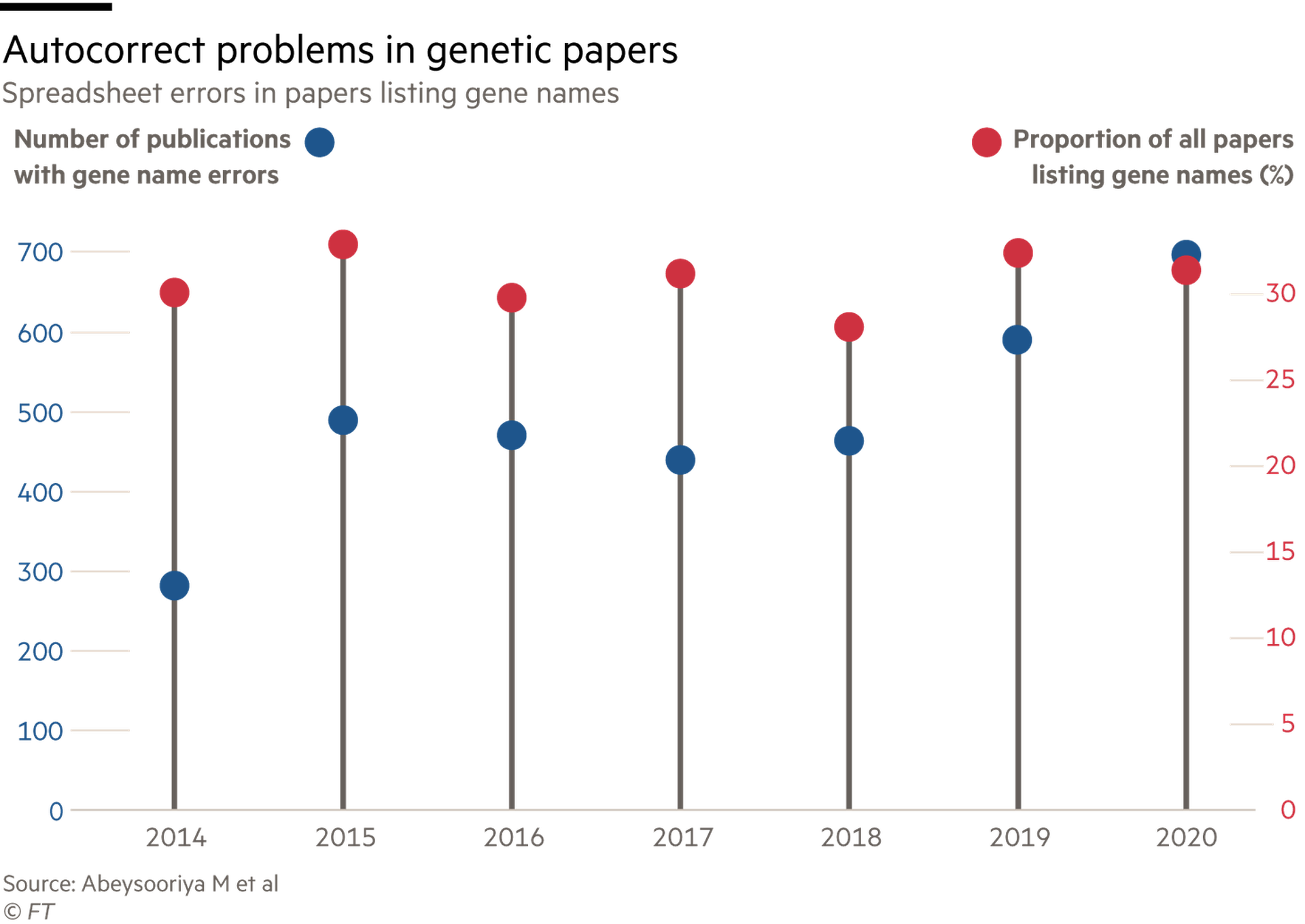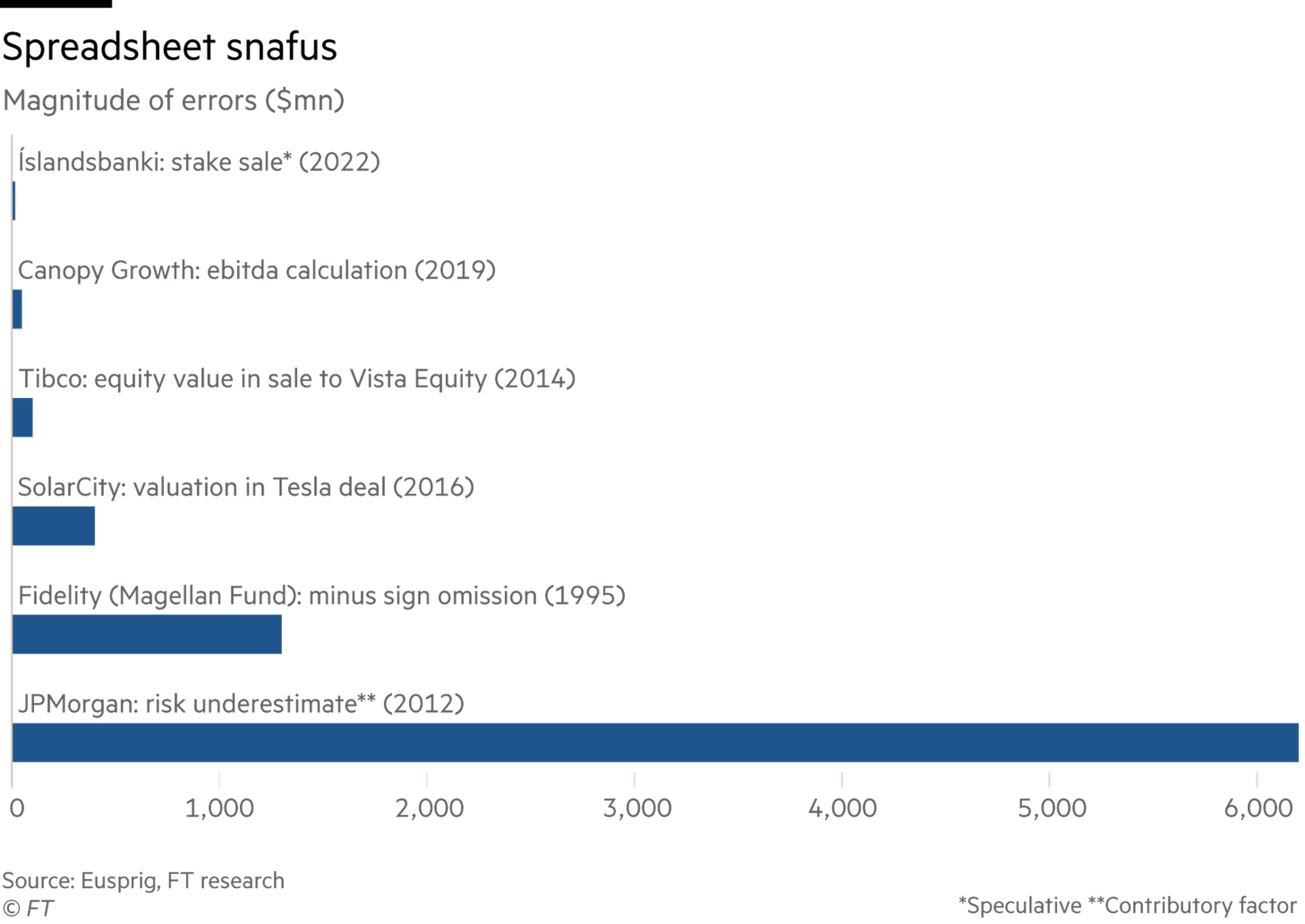尊敬的用戶您好,這是來自FT中文網的溫馨提示:如您對更多FT中文網的內容感興趣,請在蘋果應用商店或谷歌應用市場搜尋「FT中文網」,下載FT中文網的官方應用。
Spreadsheets are staples of business life. But — as with sausages and laws — it is harder to respect them if you know how they are made. Users are overwhelmingly self-taught. The migraine-inducing slog of plugging numbers and formulas to a tight deadline invites shortcuts. Unsurprisingly, errors are rife. Research suggests nine out of 10 spreadsheets contain a mistake.
電子表格是商業生活的必需品。但是,就像香腸和法律一樣,如果你知道它們是如何製作的,你就很難尊重它們。絕大多數用戶都是自學成才的。在緊迫的截止日期前填入數字和公式,這種讓人頭疼的苦差事容易讓人走捷徑。不出所料,錯誤頻發。研究表明,90%的電子表格都存在錯誤。
Iceland mispriced its sale of a slug of Islandsbanki shares earlier this year, after an Excel spreadsheet omitted investors’ offers that had included “foreign commas or amounts defined as text”. The impact is disputed but might have cost as much as $16mn.
今年早些時候,冰島在出售Islandsbanki的部分股票時定價有誤,原因是一份Excel電子表格漏掉了包含「定義爲文字的外國逗號或金額」投資者報價。其影響是有爭議的,但可能花費高達1600萬美元。
Such failures of data error cleaning and testing are all too common, according to the European Spreadsheet Risks Interest Group (Eusprig). This group of researchers has been sounding the alarm for 20 years. High on its list of spreadsheet horror stories was JPMorgan Chase’s $6.2bn “London Whale” trading losses in 2012. That featured an error-ridden model that required data to be manually copied and pasted from one spreadsheet.
據歐洲電子表格風險利益組織(Eusprig)稱,這種數據錯誤清理和測試的失敗太常見了。這羣研究人員20年來一直在敲警鐘。摩根大通(JPMorgan Chase) 2012年62億美元的「倫敦鯨」(London Whale)交易虧損,是該公司電子表格恐怖事件中最嚇人的一件。那是一個錯誤百出的模型,需要從一個電子表格中手動複製和粘貼數據。

A spectacular blunder in an influential Harvard University paper on public debt and growth cast doubt on a cornerstone of the austerity policies introduced after the financial crisis. The mistake was a simple one: the accidental omission of five rows of data when calculating an average.
哈佛大學(Harvard University)一篇有關公共債務與成長的頗具影響力的論文中出現了一個驚人的錯誤,讓人們對金融危機後推出的緊縮政策的基石產生了懷疑。這個錯誤很簡單:在計算平均值時意外遺漏了5行數據。
Another nightmarish slip-up arose when Public Health England misplaced nearly 16,000 Covid-19 test results. That was because someone had used the wrong Excel file format, XLS, which only has about 64,000 rows, so some cases vanished off the bottom.
還有一個噩夢般的失誤是英國公共衛生署(Public Health England)丟失了近1.6萬份疫情檢測結果。這是因爲有人使用了錯誤的Excel檔案格式XLS,這種格式只有大約6.4萬行,所以一些檢測結果從底部消失了。

Sometimes, tools meant to help with accuracy add to the problem. Autocorrect errors are the bane of geneticists. Nearly a third of publications featuring gene names contain errors where the abbreviated form of a gene’s name is incorrectly recognised as a date. For example, SEPT4 (septin 4) is changed to 4-Sep.
有時,旨在幫助提高準確性的工具會使問題更加嚴重。自動校正錯誤讓遺傳學家感到頭疼。近三分之一的以基因名命名的出版物含有錯誤,基因名的縮寫形式被錯誤地識別爲日期。例如,SEPT4 (septin 4)被改爲4-Sep(9月4日)。
People do not take spreadsheets seriously enough, says Eusprig’s programme chair, Simon Thorne. Unlike software engineers who typically spend 40 per cent of their time testing their coding, many spreadsheet users hardly bother.
歐洲電子表格風險利益組織主席西蒙•索恩(Simon Thorne)表示,人們對電子表格的重視程度還不夠。軟體工程師通常會花40%的時間來測試他們的代碼,與之不同的是,許多電子表格用戶幾乎不會爲此費心。
Moreover, people are bad at picking up their own errors. Self-review catches, at most, about two-thirds of errors, according to research by Ray Panko of the University of Hawaii. Overconfidence is at the heart of the problem. People tend to be proudly aware of errors they fix. But they have no idea of how many remain.
此外,人們不善於發現自己的錯誤。根據夏威夷大學(University of Hawaii)的雷•潘科(Ray Panko)的研究,自我檢查最多能發現三分之二的錯誤。過度自信是問題的核心。人們往往會自豪地意識到他們所修正的錯誤。但他們不知道還有多少錯誤沒有被發現。